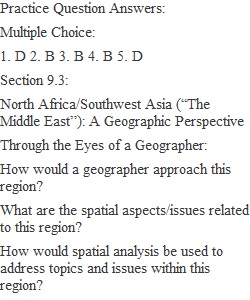


Q Section 9.3: North Africa/Southwest Asia (“The Middle East”): A Geographic Perspective Through the Eyes of a Geographer: How would a geographer approach this region? What are the spatial aspects/issues related to this region? How would spatial analysis be used to address topics and issues within this region? What are the where and why questions? How can this region be studied and analyzed using the five themes of geography? How do most Americans perceive this region? Overview: In recent years much attention has been given to the North Africa/Southwest Asia region (commonly known as the “Middle East”). Most of the information presented in the popular media tends to be highly selective and promotes stereotypes and negative perceptions of the peoples and places of the Middle East. This region is located at a crossroads where Africa, Asia, and Europe meet. The influence of these three regions is clearly visible in the diverse cultural landscapes of the Middle East. Although much attention is given to the ancient civilizations of Egypt and Mesopotamia and the three monotheistic religions (Judaism, Christianity, and Islam), information about daily life, current economic conditions, and cultural variation is not often promoted or widely sought out by most people in the United States. As a result, people from this region, especially Arabs and Arab Americans, are most often stereotyped, misunderstood, and viewed as a culturally homogeneous group – meaning that all people are the same. Some of the most common stereotypes of people in this region include being labeled as “exotic,” “extreme,” “different,” and “not like ‘us’.” Furthermore, despite a long-established presence in the United States, Arab Americans are often viewed as “the cultural other,” having a status that is less than “fully American.” Finally, for numerous reasons, the United States views this region as holding great strategic and significant importance. Critical Thinking/Discussion Questions: 1. What is the correct definition of an Arab? What is the determining factor that makes someone an Arab? Are all Arabs the same? Are all people living in this region Arabs? 2. When did Arabs begin migrating to the United States? What do you know about Arab Americans? 3. What is the best, most geographically accurate name for this world region? Why are the other common names for this world region inaccurate or misleading? What are the origins of the term “Middle East?” Practice Questions (Write Correct Answer in Blank): Multiple Choice: 1. ___ About __ percent of Arab Americans are Christian: A) 2% B) 23% C) 39% D) 52% 2. ___ The great ancient civilization of Mesopotamia was located in this present-day country: A) Syria B) Iraq C) Afghanistan D) Egypt 3. ___ After WW I Great Britain and France divided the remains of this empire between them, again bringing foreign control to the Middle East: A) Egyptian B) Ottoman C) Persian D) Mesopotamian 4. ___ The State of Israel was created by the United Nations in: A) 1939/40 B) 1947/48 C) 1954/55 D) 1962/63 5. ___ This language developed due to the need for East Africans and Arabs to communicate for trade: A) Shona B) Ndebele C) Afro-Arabic D) Swahili True or False: 1. ___ In terms of religion, the majority of Arab Americans are Christian. 2. ___ Many great human advances and innovations originated in the Middle East. 3. ___ This region is the home of the world’s three monotheistic religions. 4. ___ All people living in this world region share one unified culture. 5. ___ Saudi Arabia holds the world’s largest Muslim population.
View Related Questions